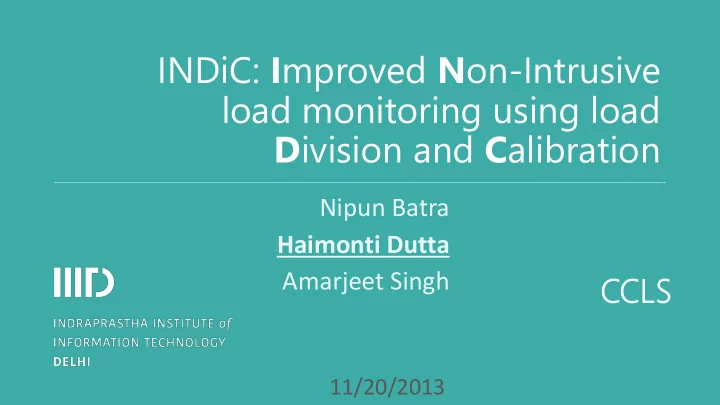

INDiC: I mproved N on-Intrusive load monitoring using load D ivision and C alibration Nipun Batra Haimonti Dutta CCL CLS Amarjeet Singh 11/20/2013
Motivation • Buildings contribute significantly to overall energy (electricity, gas, etc.) usage • New buildings constructed at rapid rate 100 80 India 60 US 40 UK 20 0 2
Efficacy of appliance specific feedback Providing appliance specific feedback to end users can save upto 15% energy. 3
Systems for providing appliance specific feedback Appliance monitors Smart meter Provide appliance specific Give whole home power information information Scale poorly Information must somehow be broken into different Cost increases with each appliances appliance Non intrusive Intrusive Cost effective 4
Non Intrusive Load Monitoring (NILM) Breaking down aggregate power observed at meter into different appliances 5
Why NILM works? Each appliance has a unique signature This is based on the appliance circuitry Borrowed from Empirical Characterization and Modeling of Electrical Loads in Smart Homes, Barker et. al 6
Key Idea I-Load division Different loads are assigned to different mains Smart meter capable of measuring individual mains 7
Key Idea I-Load Division Instead of doing NILM on Mains 1+ Mains 2, as done before, perform NILM on both separately Intuition: Separating out independent components Less noise (as noise is distributed too!) More scalable 8
Key Idea II- Calibration Different appliance monitors may measure different power for the same appliance 9
Key Idea II- Calibration Power change measured by appliance monitor is significantly lesser than the measurement done at mains 10
INDiC Calibrate Processed Apply NILM Mains 1 data Raw data Mains 1 data Load division Calibrate Processed Apply NILM Mains 2 data Mains 2 data 11
Experiments-I Load Division REDD dataset from MIT Problem complexity almost halved! Overall Mains Mains 1 2 Dishw Stove Kitchen Refrigerator Microwave Lighting asher 12
Experiment II Calibration • Unaccounted power or noise reduces after calibration • Should improve accuracy Before calibration After calibration 13
Combinatorial Optimization (CO) based NILM • Take all possible combinations of appliances in different states and match to total power • Exponential in number of appliances • Load division gives exponential improvements!! Toy example illustrating CO Fan AC Total Power (W) OFF OFF 0 OFF ON 1000 ON OFF 200 ON ON 1200 14
Evaluation Metrics Mean Normalized Error (MNE) Normalized error in energy assigned to an appliance Given by |/ |𝑄𝑠𝑓𝑒𝑗𝑑𝑢𝑓𝑒 𝑄𝑝𝑥𝑓𝑠 𝑢 − 𝐵𝑑𝑢𝑣𝑏𝑚 𝑄𝑝𝑥𝑓𝑠 𝑢 |𝐵𝑑𝑢𝑣𝑏𝑚 𝑄𝑝𝑥𝑓𝑠 𝑢 | 𝑢 𝑢 RMS Error (RE (Watts)) RMS error in power assigned to an appliance 15
[i,j] entry: Results Number of instances Refrigerator’s accuracy improves significantly in i th state predicted Refrigerator Confusion Matrix in j th state Without INDiC With INDiC State 1 State 2 State 3 State 1 State 2 State 3 State 1 4740 288 41 State 1 4541 430 98 State 2 1775 2860 176 State 2 221 4434 156 State 3 112 63 25 State 3 5 44 151 16
Results -II Both MNE and RE reduce significantly after applying INDiC Appliance Without With INDiC INDIC MNE (%) RE (W) MNE (%) RE (W) Refrigerator 52 91 25 67 Dishwasher 662 131 73 52 Lighting 176 64 63 43 17
Acknowledgments TCS Research and Development for supporting Nipun Batra through PhD fellowship NSF-DEITy for project fund 18
Recommend
More recommend